Cyanobacteria (blue-green algae) are a nuisance that form in water and excrete Microcystin, a toxin that is hazardous to animals and humans when consumed. It also affects the flavor of many aquatic creatures commonly eaten as seafood. In recent years, blooms of blue-green algae have resulted in sick people and dead animals. They have also caused economic hardship for communities, stemming from lost recreational revenue and property devaluation.
These problems still occur today, as exemplified by the most recent Microcystin toxin incident in Toledo, Ohio. There, contaminated drinking water disrupted daily life for some 500,000 residents and caused undo expenses for restaurants and other organizations — not to mention the expense of treating the contaminated water to remove the toxins. Toledo’s problems have garnered national attention at present, but they could have been spotted well in advance had greater attention been given to the increasing presence of blue-green algae blooms covering parts of western Lake Erie and many inland lakes.Control of blue-green algae is difficult because of climate conditions, the size of the water bodies affected, and – most challenging of all – the accumulation of phosphorus in the water. Phosphorous enters lakes and ponds primarily through agricultural and waste-treatment sources. In the long term, the amount of phosphorus that these sources discharge into the water will need to decrease dramatically. In the meantime, a more immediate intervention is to maintain clean drinking water by controlling algae formation directly.
This article describes one such approach and outlines its potential for combating toxic algae.It is well known that cyanobacteria cells grow rapidly by consuming nutrients from the water (nitrogen and phosphorus), carbon dioxide from the air, and sunlight. To control cyanobacteria growth, it is necessary to interrupt this nutrient cycle. Most approaches target the cyanobacteria’s phosphorus supply. As important as such phosphorous-directed approaches are, alternatives should be considered; for, while it is necessary to reduce phosphorus levels in the long term, doing so will likely take decades, and faster-acting solutions are at our disposal at this very second. Cyanobacteria are single-cell organisms that grow naturally in fresh and salt-water environments. These are bacteria that can synthesize chlorophyll – hence their blue-green color. They use sunlight to manufacture carbohydrates from carbon dioxide and water (the technical term is photosynthesis). They contain small gas pockets within their cells that allow them to control their buoyancy, enabling them to sink or rise to move to where nutrient and light levels are highest.
As mentioned above, cyanobacteria need nutrients to grow, specifically nitrogen, phosphorus, and carbon. One problem with controlling cyanobacteria is that most aquatic organisms do not eat them because of the toxins they produce. Left to grow unimpeded, cyanobacteria algae blooms can have serious ecological and aesthetic consequences. For example, as the algae die and decompose, they use up a large amount of oxygen, resulting in oxygen deficiency (eutrophication) and increased concentrations of toxic ammonia – both of which stress aquatic life and cause large “kills” of aquatic species. The odorous toxins from cyanobacteria can also migrate through the skin of some aquatic creatures and accumulate in their bodies, which negatively affects their taste when consumed by humans.

 Usually we think of bacteria as dangerous entities due to their association with infection and food poisoning. In fact, however, the number of beneficial bacteria far outweighs the number of potentially harmful bacteria. Indeed, bacteria are absolutely crucial to the natural recycling of nutrients throughout the environment. Without them, dead organic material would simply fail to decompose at an ecologically viable rate. This decomposing function of bacteria—their ability to consume a wide range of organic matter, break that matter down into its nutritive building blocks, and cycle it back into the ecosystem in a more beneficial form—is precisely what makes them such a powerful tool for aquaculture and pond health.
Usually we think of bacteria as dangerous entities due to their association with infection and food poisoning. In fact, however, the number of beneficial bacteria far outweighs the number of potentially harmful bacteria. Indeed, bacteria are absolutely crucial to the natural recycling of nutrients throughout the environment. Without them, dead organic material would simply fail to decompose at an ecologically viable rate. This decomposing function of bacteria—their ability to consume a wide range of organic matter, break that matter down into its nutritive building blocks, and cycle it back into the ecosystem in a more beneficial form—is precisely what makes them such a powerful tool for aquaculture and pond health.
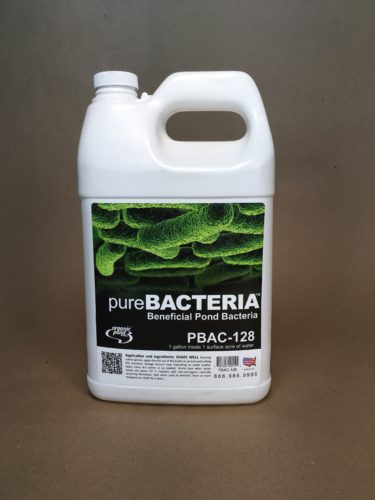
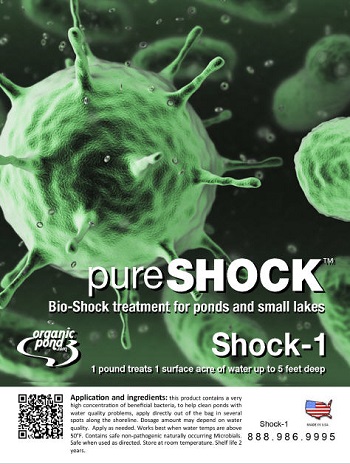
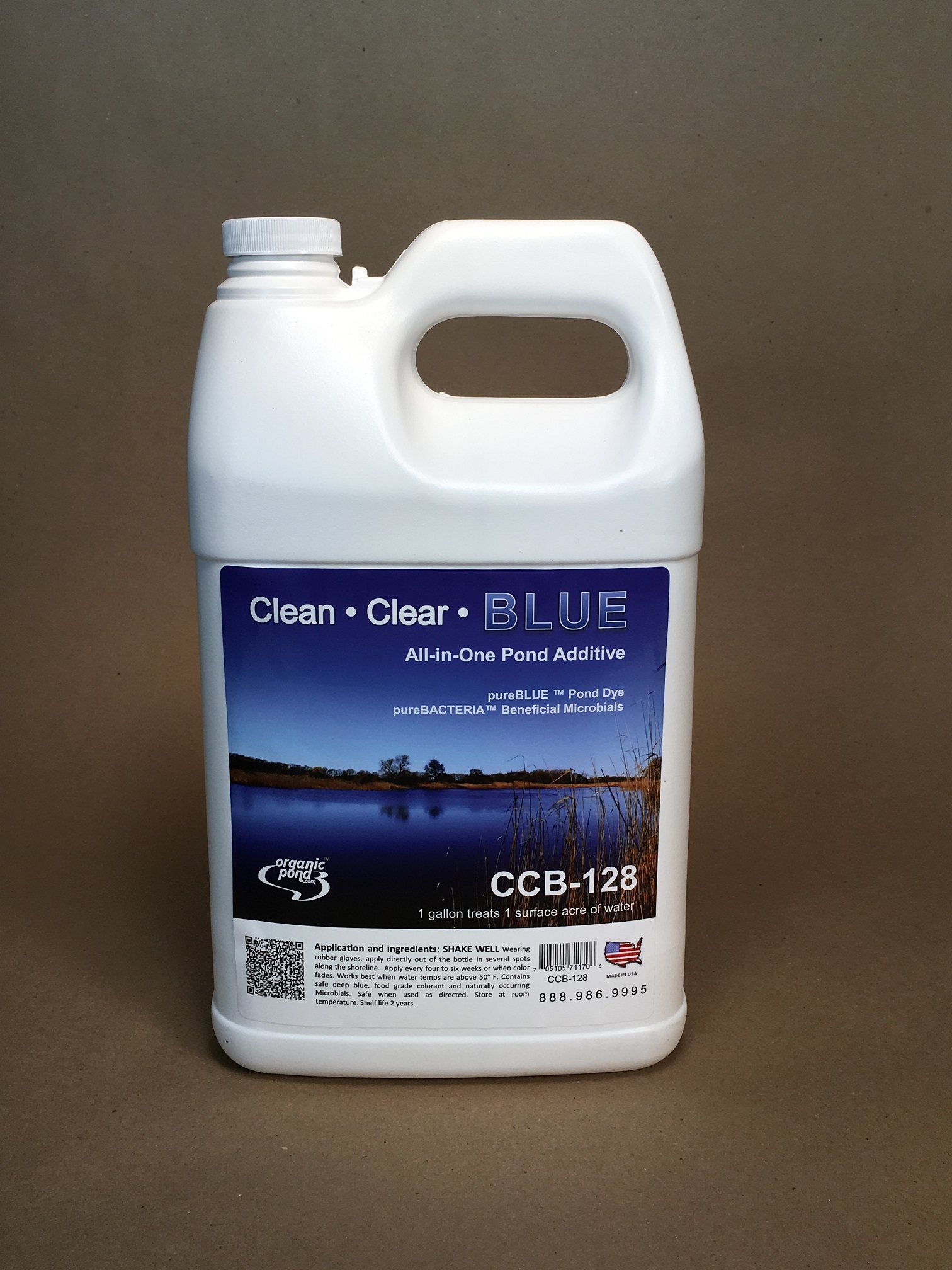
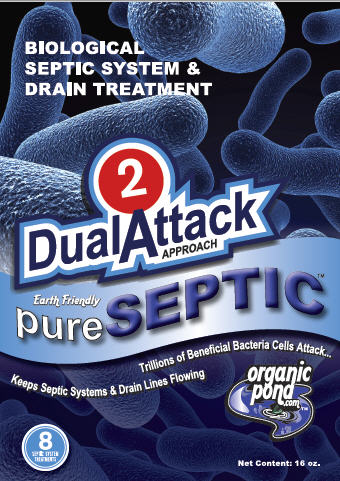
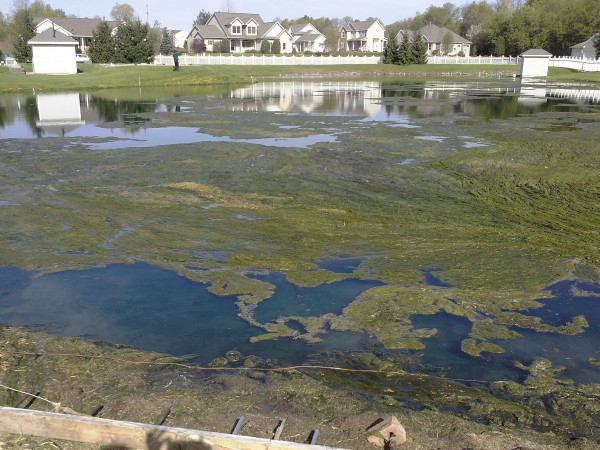
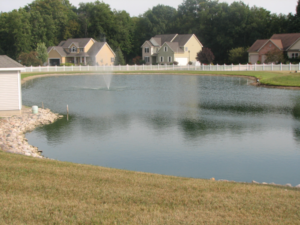
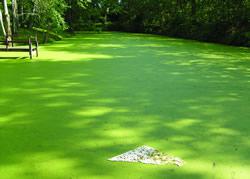
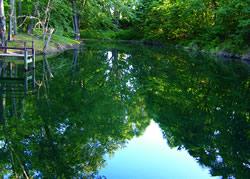
 concentrations are high. One example is illustrated in pictures of a holding pond that has been continually supplied with water from a small community waste-treatment facility. Phosphorus in this pond varied consistently between 3.3 and 4.7 ppm (mg/L) – levels much higher than what would typically be found in a water body. For 5 summers, this pond was covered with algae, making it a smelly, odorous eyesore. Homeowners would rake algae from the pond and dispose of it in nearby woods, but it would quickly return. In 2013, the pond was treated with high concentrations of beneficial bacteria and within weeks, the water cleared up (bottom picture). The pond has remained this way ever since, in spite of the phosphorus and other nutrients that continue to flow into it.
concentrations are high. One example is illustrated in pictures of a holding pond that has been continually supplied with water from a small community waste-treatment facility. Phosphorus in this pond varied consistently between 3.3 and 4.7 ppm (mg/L) – levels much higher than what would typically be found in a water body. For 5 summers, this pond was covered with algae, making it a smelly, odorous eyesore. Homeowners would rake algae from the pond and dispose of it in nearby woods, but it would quickly return. In 2013, the pond was treated with high concentrations of beneficial bacteria and within weeks, the water cleared up (bottom picture). The pond has remained this way ever since, in spite of the phosphorus and other nutrients that continue to flow into it. 